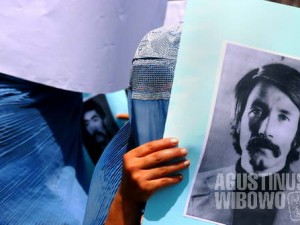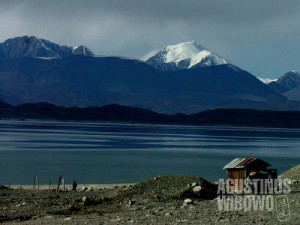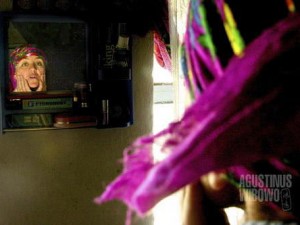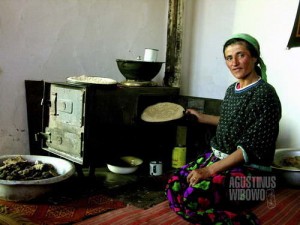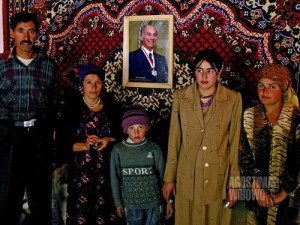history
http://www.cctss.org/portal.php?mod=view&aid=801 Interview during 2015 Sino-Foreign Audiovisual Translation and Dubbing Cooperation Symposium, in correlation with Shanghai International Film Festival 2015. 【影视】我愿搭起一座桥梁——对话印度尼西亚作家、翻译家翁鸿鸣 2015-07-22 14:45| Original author: 徐奕欣|Location: 中国文化译研网 Description: 有这样一位印尼华侨,他第一次将中国的文学作品直接翻译成印尼语,引入印度尼西亚;他又用自己的生花妙笔,写下他在寻根之旅的种种感悟,直接展示了一个印 尼华侨关于故乡和他乡的思考。他是翁鸿鸣(Agustinus Wibowo),印度尼西亚裔华人,双语作家,自由翻译者,同时也是将余华作品翻译引入印度尼西亚的第一人。 东南亚地区集中了大量的华人, [read more]
The Palace of Illusions
When drawing a picture about memory of the past, we tend to have only two alternatives. Either we amplify good memories and minimize the bad ones, or the other way round. When the nostalgia is about history, this can be dangerous, as the history may turn to an illusion, no matter how real the events are. The incidence of nostalgia may bring you to homesickness. American physicians in nineteenth century even pointed out that acute nostalgia led to “mental dejection”, “cerebral derangement” and sometimes even death. In Indonesia, the so-called history is never so long ago. Some people say, Indonesians have such short memories as they suffer from “history amnesia”. With most of its population are less than 30 years old, majority people did not really experience the whole history of the Republic, from the Independence struggle era (1940s), Sukarno’s Old Order (1950s), the chaos before the arrival of Suharto’s New Order (1960s), and the never ending period of [read more]
Kabul – Women Call for Justice
Blue Demonstration Under the scorching sun they yelled, they cried, they screamed. Many of them were completely wrapped by blue burqas. Many of them were invisible. But grieves and cries were heard and tears were felt. The message was clear: call for justice. A group of more than 100 protesters, mostly women, held a demonstration in front of a UN mission office in Kabul today. They brought photos of men. The photos, seen from the fading black and white, are presumed old portraits. Who are the women? Who are the men? Before we go further, let me introduced you to a happening in Kabul some weeks ago. A discovery of mass graves located in Dasht-e-Chamtala, a desert some kilometers away from Central Kabul, in early and mid-July, shocked the country. The last mass grave contained at least 1000 bodies. The human remains reminded all to the two and half decades of wars in the war-torn republic. Bones, skeletons, even scraps of clothes of various colors, each has their own history and [read more]
Kabul – Funeral Ceremony of the ‘Father of Nation’
I have the rare opportunity to attend the state funeral ceremony of Muhammad Zahir Shah, the former and the last king of Afghanistan, who died at the age of 92. The king reigned from 1933 to 1973, before being overthrown by his own cousin Muhammad Daoud who started the history of Afghanistan as a republic. The forty years of his monarchy leadership was always remembered as the peaceful era in Afghanistan history, which had been almost always carved by blood. His father, the king Nadir Shah, was assassinated by a student, which then brought the young Zahir, 19 years old at that time, to the throne. Assassinations and bloody coups are not new things in Afghanistan. Nadir came to power also due to a bloody civil war rouse by the controversial modernity programs promoted by the former king, Amanullah Khan. In 1929, there were three different kings sat on the throne consequently. People were sacrificed in struggle to power. It is blood which dominated history of Afghanistan. During the [read more]
Kabul – Long Holiday
King Zahir Shah on an old Afghanistan postage stamp. “Iran has banned national flag from flying at half-mast during mourning period, because the flag contains holy symbols of ALLAH, holy sentence of ‘la illaha ha ilallah (there is no God but ALLAH), and ‘Allahoakbar (Allah is great),” said an article on an Indonesian Internet newspaper today. I was interested by this topic, and asked my colleague whether Afghanistan has the same policy. My friend didn’t understand my question. “What is half mast?” he asked “It is the culture to fly the national flag at half portion of the pole, to show mourning,” I answered. “Why mourning?” he still didn’t get my question. “Well… for example, there is someone very, very important in the country, dies. Then all people in the country mourning. Then it’s the culture to put the flag at half of the pole.” “Why doing that?” he asked me more than what I was asking. “I don’t know. That’s the culture everywhere.” [read more]
Kabul – Brother Ambassador
The Indonesian Embassy in Kabul Today there is opening of a photo exhibition in the newly renovated Kabul Museum, just across the Darulaman Palace. The exhibition shows some old photos of Afghanistan, taken in the 1970s, about the glorious era of the covered bazaar of Tashkurgan. The covered bazaar now is gone. And European historical site preservation mission is trying hard to return the legendary bazaar back to its golden time. As photographers we were invited to attend the opening ceremony. There were long, long speeches from authorities and historians about the importance of preserving historical sites, the mission of photo exhibition, and about the destroyed bazaar of Tashkurgan. Many of the invited guests are foreigners. I feel a strange feeling surrounded by high class Afghan expats accompanied by their super muscular bodyguards. I am just a little photographer assigned by a local office here. During the speech I noticed a man standing next to me. He also looked at me. I was [read more]
Shakhimardan – An Uzbek Island Surrounded by Kyrgyz Mountains
Shakhimardan, an Uzbek “island” surrounded by Kyrgyzstan As artificial as any other thing in Central Asia was the border lines between the countries. The nations created by the Soviet rulers now had to be provided their homeland. Stalin might say, land populated by most Uzbek should be Uzbekistan, those inhabited by mostly Mongoloid Kyrgyz then became Kazakhstan (the Kazakh was called as Kyrgyz) and Kyrgyzstan (of which people was called as Black Kyrgyz). But the matter was not simple in the Ferghana Valley. Ferghana Valley was always a boiling pot in Central Asia. The people were renowned as deeply religious Muslim, if not fundamentalist. It was more than necessary for the Russian to divide this huge mass with the highest population density all over Central Asia. Then, besides the division of ethnics (who were Uzbek, who were Kyrgyz, and who were Tajik), there was a clever intrigue by dividing the border lands to divide the people. Then, the identity in Ferghana Valley [read more]
Toktogul – The Kyrgyz Language
It still looks so Russia It is the first chance for me to get acquainted with one of the Turkic languages. Kyrgyz, as well as Kazakh, Uzbek, Turkmen, Turkish, and Mongol are Turkic languages. The first five are quite close each other, but Mongol is completely intelligible to other Central Asian Turkic speakers. Some linguists put Korean and Japanese in the Turkic language group, due to similarity of word order and agglutinative verbs. But newer linguistic classification, as what I believe, has thrown away the two Oriental languages out of the group. Before getting confused, please notice the difference between ‘Turkic’ and ‘Turkish’. The Turkic languages family is a group of languages with similarities of grammar and word forms, which includes Turkish and most of Central Asian languages. Books for learning Kyrgyz in English language are quite difficult to find even in Kyrgyzstan, and I was lucky that I met two Peace Corps volunteers who lent me the grammar book. For me, Turkic [read more]
Karakul – the Giant Death Lake
The giant death lake of Kara Kul. Karakul in Kyrgyz language means ‘black lake’. The lake itself is not black. In fact, this huge water body was deep blue when the sky is friendly, and turns to be grey when the sun chooses to hide behind the clouds. But the life is as dark as its name. There is no life at all in this huge lake. The lake has high concentration of salt. But despite of the salt, the lake also freezes in winter. The village next to the lake, bears the same name, is a Kyrgyz settlement with only one Tajik man inhabitant – a policeman. I was supposed to stay with the Tajik policeman, as it’s the only chance for me to communicate with my Persian knowledge. But when I arrived there, the Tajik man had left to Khorog.I stayed with a Kyrgyz family, an Acted-arranged guest house. They don’t speak Tajik, but the husband know little bit and can sing the national anthem proudly, “Zindabosh e vatan Tajikistan e azadi man (Long Live o Fatherland, My Free Tajikistan!)” He [read more]
Murghab – Life in Murghab
A morning greetings from Murghab Murgab (Murghab) was promising when it was built. It was a new Russian settlement built as frontier city of Pamir. The highway connecting the isolated mountains to the lowland towns was supposed to bring wealth to the nomadic community. Life had changed ever since. A town was built on the top of mountains. People were educated. Frontier military checkpoints were enforced. But how is life now, after Tajikistan gained independence from the USSR and civil war took place in the new country? The hope of the future had turned to be a bad fate. I had got a chance to know Gulnara, a 54 year old woman working as a primary school teacher in Murgab. Gulnara is the younger sister of Khalifa Yodgor from Langar. But the last time she saw him was 2 years ago. “It is too expensive to go there,” said her. Langar is not too far from Murgab. It is around 250 km only, but the public transport there is very rare and expensive. At present, Murghab-Langar cost 50 [read more]
Murghab – The Dudkhoda’s Family
Boys of Murghab, in front of Tajik banner with the tricolor flag and coat-of-arms, of which important element is a snow mountain “Pamir will be better…. Pamir will be better….” – Dudkhoda My first impression of this 39 year old Tajik man was really not so good. this man tried to hug me and kiss me when I was sleeping next to him under the same blanket on the floor in the Kyrgyz restaurant in alichur packed by the Kyrgyz drivers. He also made me to pay his bills in the restaurant. But later I found that he had story worth to tell. He arranged for me a seat in the Kyrgyz truck, along with him, who returned to his home in Murghab. He was actually a passenger of the truck, not being able to pay the ride with money but offered the drivers a dinner in his hosue in Murghab. I came along with him, sitting along the way to Murghab (100 km) for free. Just near Murghab, there were two military checkpoint. The Kyrgyz drivers failed to do registration and they became [read more]
Langar – Connecting Afghanistan
Yodgor family. Aga Khan portraits always decorate the houses of Ismaili families in Tajikistan Pamir. Three months ago, on July 31st exactly, I came to this little bridge. That time I was coming with the Shah (the King) of Panjah, district officials of Khandud, and Afghan soldiers. At that time, we were there to see the opening of the bridge and overwhelmed by the optimistism of the desperate Wakhi people from Afghan side, about the change of their future by this new border. Today, I am at the other side of the bridge, seeing the barren hills of Afghanistan with all of its hopes, from Tajikistan side, with Mulloev Yodgor Dildorovich, the khalifa (religious leader)-cum-teacher of Langar. Yodgor was among those who were overwhelmed by millions of mixed feelings when the border was opened, only for one day. On August 1, 2006, there was held an Afghan bazaar just next to the bridge in Langar side. The people from Afghanistan Wakhan Corridor were coming from all directions, from as far as [read more]
Vrang – Life in Vrang
Green, peaceful, and lazy … Vrang Travelling in Tajikistan side of the Wakhan Corridor was as difficult as in Afghanistan side. Public transport was rare, the oil price got higher as the altitude got higher. It was 3.50 Somoni per liter of petrol here. No one was sure when the coming transport would come. And even when it came, it was often full, no space to share. It was indeed luck to be able to travel according to what one has planned. I was patient enough even though I worried about my short visa. Dr Akhmed was a doctor in Tughoz. I was waiting for transport to Vrang, 5 km away from tughoz, in his hospital. As the main doctor in this village, he earned only 50 Somoni per month. You would go nowhere with that amount of money in Tajikistan. But everybody was optimistic with his life. Working with little income was still better rather than begging on the streets. I have heard beggars in Jakarta could earn at least 60 dollars per month, about 280 Somoni, or 4 times higher than [read more]
Ishkashim – Peeping into Afghanistan
Afghanistan, seen from Tajikistan It is just separated by a river. But the live over there is a world away. Khorog and Ishkashim are connected by a stretch of a 106 km long asphalted road. It is a 3 hour journey with public jeep, but cost as much as 20 Somoni ($6). Despite of lack of money that people earn, everything in Tajikistan is very expensive as the country produces almost nothing remarkable but water and electricity. The road to Ishkashim as along the Panj river, with Afghanistan Badakhshan province at the other side. The river itself had not strong stream (as the temperature is already quite low at this moment) and was not wide at all. Afghanistan is just less than 20 m from here, but the life there is a world away. While we are traversing smooth road of Tajikistan with a jeep, the road over there is complete dirt road and you may observe Afghan travellers wandering the world on donkeys. When women passengers in our jeep in Tajikistan side sit aside the other male passengers, [read more]
Khorog – The Capital of GBAO
Driver is a respected job in Tajikistan, especially in GBAO where most people still struggle of unemployment “Thanks to God, thanks to Aga Khan, for their kindness to us” – Mamadrayonova Khurseda The provincial capital of GBAO, Khorog, is a little town set in a valley surrounded by vertical cliffs of high mountains. It is cool and lazy, and despite of its proximity with Afghanistan, it is quite laid back. The appearance of military still can be felt intensively in the town, thanks to the neighbouring Afghanistan, which is just across the river and notorious for opium export and illegal border crossing. Young soldiers have to patrol every morning along the misty and freezing river. The 1300 km long border with Afghanistan gives much headache to Tajikistan, and its patron – Russia. Russian guards were playing a big role in ‘saving’ the war torn Tajikistan from further deterioration. But as the situation of the country had been stabilized for almost ten years now, the [read more]
Khorog – The Journey to GBAO
One of the two brothers, fellow passengers on the journey to Khorog, GBAO, Tajikistan GBAO, the Gorno Badakhshanskaya Avtonomnaya Oblast (Gorno Badakhshan Autonomous Oblast) is my main reason to come to Tajikistan. It is dominated by the minority Ismaili Badakhshani Tajiks and Sunni Kyrgyz. It has majestic mountain architectures. But the main reason I want to go to this restricted area was its history. The province was supporting rebel side in the civil war of Tajikistan. The province suffered a lot from the blockade of the central government. Going to Tajikistan is already something strange for my Indonesian friends in Kabul. “Why going to Tajikistan? It is a poor country.” Going to GBAO is another thing to be objected by my Tajik friends in Dushanbe. “Why going to GBAO? It is so far and poor…” Even the Tajik diplomat in Kabul raised his eyebrows when my embassy staff insisted to get a Tajik visa together with GBAO permit. “Is he really a tourist???” For the ‘GBAO’ [read more]
Istraravshan – The 2500 Years of History
The 2500 years of history, Istaravshan Tajikistan has to dig up very deep into its glorious past to emphasize its identity. Tajikistan had to leave behind its historical luggages, as the Persian Tajik civilization centres, Samarkand and Bukhara, were handed to Uzbekistan by the Soviet government. Among what was left now, it was Istaravshan to testify to glory of this tiny country’s past. Istaravshan is located about 280 km north of Dushanbe, after passing two high passes of Anzob and Ainy (Shakhristan), both are higher than 3700 m. The passes are covered by snow in winter, making it’s impossible during the period to travel overland from Dushanbe to Khojand – the second city of the country. The only possible transport by that time is by flying. Along the way there were many Chinese workers on road and tunnel construction projects. They navigated the tractors, measured the parameters, and broke the stones. I did really wonder why it was so necessary to have all Chinese workers to [read more]
Dushanbe – Tajikistan, First Impression
Just across the river border, even the grilled meat looks very different, despite of the same name, kabab. Oh, it also gets a Russian name here, sashlik. Before actually physically stepped on the country, I had heard, and seen Tajikistan when I was still in Afghanistan. It is the country idolized by many people in the Badakhshan province. It is the country of freedom, flourished by goods, electricity, and public services. It is the country where women can walk on the streets freely without fear of not covering properly. Now, I am in Tajikistan, seeing and experiencing what man of the northern rural Afghans dreaming about. But for me, Tajikistan is not about dream. According to a reference, the average salary of the people in the country was only 61.81 Somoni (US$ 19.93/month, 2005) and average pension was as low as 16.92 Somoni (US$ 5.23/month, 2005). Life cost is not cheap at all, at least in Dushanbe, compared to the low income statistics. Long distance transport was incredibly [read more]
Garmao – The Minaret of Jam
The legendary Minaret of Jam “What was illegal has to be legal now, but what is legal is still illegal.” – Mohammad Yousuf Nassir Ahmad, a driver from Heart, owned a Mazda truck. His Mazda served as a public transport to the villages along the Central Route of Afghanistan, especially for those in Heart and Ghor provinces. From Garmao, some traders from the Jam village hired his car to transport their trading goods, and Nassir offered me a ride to the historical minaret of Jam. We departed from Garmao at 5:30 in the morning, delayed an hour from the initial planned time. Garmao, literally means ‘hot water’, seemed got its name in mistake, as the morning was extremely freezing. The truck had been loaded by goods of the traders, from rice, wheat, until strawberry jam and carbonated drinks Zam Zam from Iran. We, the hitch-hikers, sat on the open truck on the trading goods. The wind was very strong, and chilled. The rugged hills of Ghour province. Transport in [read more]
Mazhar e Sharif – The Holy City
The holy shrine The skyline is dominated by the blue domes of fantasy-like architecture of the mausoleum, along with hundreds of white pigeons flying around to seek fortune. Mazhar e Sharif, once a small village overshadowed by the nearby Balkh, now is the biggest city in northern Afghanistan. Mazhar-e-Sharif, literally means Tomb of the Exalted, had passed different path of history Kabul had experienced. It was Russian stronghold area and it was under the occupation of communist general Rashed Dostum, an uneducated warlord who once the big ruler of Northern Afghanistan. Dostum had published his own money, what was known as Junbeshi money (Peace money), and he had his own airlines. Taliban failed to conquer Mazhar at its first attack, but succeeded in 1992 when Mazhar turned to be a city of blood. The Hazara ethnic were slaughtered. The fantasyish holy building is believed to be site where the body of Ali bin Abi Thalib lies Huge poster of the national hero, a Tajik man by ethnicity, [read more]
Balkh – The Passed Past
The ancient civilization of Balkh “I am not a communist. I am a Muslim” – Khan Agha Arvin The present day tiny town of Balkh, 30 minutes away from Mazhar e Sharif connected by high speed highway, was before a glorious capital of the Bactrian empire. Today, for the locals, the name Balkh maybe more better translated as pilgrimage sites, where hundreds of holy saints’ mausoleums are located and pilgrims came for blessing and prayers everyday. One among the pilgrims was Khan Agha Arvin, currently worked as vice director of one of Afghanistan’s most famous high schools, Lycee Istiqlal in Kabul. I met him accidentally in the pilgrimage site of Rabia Balkhi, a great Persian woman poet who died in name of love. Arvin, now 47, offered me to go with him and his colleagues around the old town. Offering prayers in holy sites which populate the whole city of Balkh The city walls of Balkh, once walls which protected the great capital of the great empire, now was rubble of history. [read more]
Qala Panjah – The Afghan Values
The question is how to unite all of them. “What are the values to be a nation?” Arnault Sera It was a long dusty journey in the dusty unpaved main road connecting the Badakhshan province to Takhar. With most roads in the country unpaved and full of dust, Afghanistan simply might be the dustiest country in the world. Traveling here is not easy either. Passengers are usually packed, pressed in carries like Falancoach, can load up to 18 passengers (many times overloaded up till 20 people) in the narrow seats of the car. Those who can afford more might choose TownAce, comfortably at 7 passengers in the car. If the road track is not too difficult, Corolla and shared taxi might be the most comfortable way of traveling. Traveling is always costly in Afghanistan. Even the cheapest Falancoach may only carry you traveling from Faizabad to Ishkashim for 550 Af (11 $) for the 160 km distance, while the same amount in Pakistan might take you 1000 km away. In anyway, traveling in countryside of [read more]
Krat – The Wakhi People of Krat
Wakhan Corridor is always far and mysterious “Zdravstvui tovarech” – a villager from Krat Freedom is what the Wakhi people are longing for. I never expected my visit to Chapursan, the Wakhi Tajik valley in northern Pakistan, brought me to learn deeper about the life of the same ethnic in Afghanistan side of the valley. In Chapursan, 7 months ago, I stayed in house of Noorkhan, a Wakhi Tajiki from Kil village, where sun doesn’t come at all in winter for 3 months. Who expected, deep in restricted area of Wakhan Corridor, I met friends and relatives of Noorkhan. Faizal-u-Rahman, 29 years old, is a cousin of Alam Jan Dario, a famous man from Zod Khon village in Chapursan, who pioneered tourism in the valley. I met Faizal in in Khandud. He was offering me a hitch on tractor to the village of Krat in Wakhan Valley of Afghanistan. He, together with other people from Chapursan are working for an American NGO, Central Asian Institute, and this moment they are building a school in the [read more]
Taloqan – The Colorful Mondays
Welcome to Taloqan “First it was the culture, then it mixed with the religion” – Sa’dat The city of Taloqan is the capital of the Takhar province, one of Afghanistan northern provinces. Takhar was part of the Qataghan province which once comprised the nowadays provinces of Kunduz, Takhar and Baghlan. Taloqan is hot in summer although compared to Kunduz, it’s much cooler. The city is dusty, but the smoothly paved road which connected the sleepy provincial capital to Kabul promised its brighter future. The city has somehow a strong link with the Islamic Republic of Iran. Unlike other cities in Afghanistan, the roads in Taloqan has clear name and road signs, and many of the main road signs in the town center are backgrounded with Iranian flag, and signed “Afghanistan and Iran”. Some of the roads have quite Iranian smell, like the “Ayatollah Khomeini” St. Some other main roads are Hafez St., and as in all other cities in Afghanistan, the “Ahmad Shah Massoud” St. [read more]
Kabul – Understanding Islam from the Eyes of a Pashtun
With enveloping burqa, a woman sees the world through the little holes in front of her eyes “In Islam there is a circle. And we cannot get out the circle” — Amin It was not easy to meet and interview people who praised a lot the Taliban regime in recent day Kabul, at least in my one month here, it was the first time I got the chance. The discussion was not political, instead it was more cultural and religious. Amin, a man of 33 years old from Pashtun ethnic, had spent his 29 years of life in Pakistan. He was a refugee. He speaks very good English, and he expressed his idea very well in the language. He used to live in a tribal area in the NWFP (North West Frontier Province) of Pakistan, the area that the Afghans preferred to refer as Pashtunistan. The tribal areas are the areas of the Pashtuns which are not under the Pakistani law. The tribal area where he lived was Mohmand Agency. His ancestors came from a village called Kandari, both existed in Pakistan and [read more]
Ghazni – From the Glorious Past
The glorious past has gone, forever The glorious past has gone Ghazni is the capital of province of the same name, located north of Zabul province on the Kabul – Kandahar highway. The altitude of slightly more than 2000 m guarantees the temperature in Ghazni is cool. At this moment, Ghazni is among the riskiest provinces in Afghanistan, where Taliban attacks happen in regular basis in the districts of the province. But as everybody tried to convince, the city is a safe place. Shehr Ahmad Haider is a Pajhwok journalist covering the news of the area. His office is a tiny office in a hotel near the bus station to Kandahar. There are two computers in his 3 x 5 m room, and his main weapons of getting news are: two sets of mobile phones and a desktop phone. He never meets Taliban, despite that most of his news dealing with Taliban. Interviews are done through phones. But he is not idle. In fact, to get at least five news per day he has to make many telephone calls and some visits to the [read more]
Kabul – The Woman Movements
Being invisible very often is necessary in a warzone “They feel save being invisible” ——— Lam Li The image of Afghan women which laid the strongest impression among Indonesians, and maybe also other nations in the world, is women hiding in blue burqa, the veil covering the whole head, including hairs, necks, face, and even eyes, makes the body under it completely anonymous. A friend of mine described burqa / burka as invisible blanket, just like the fantasies in those Japanese animations. Whoever wears this blanket will be invisible. Nobody will recognize. No recognition, no attention. “They feel save being invisible,” said Lam Li. Lam Li made her impression after staying quite a while in Pakistan and Afghanistan, particularly Peshawar and Kandahar, among the most conservative places of the two countries. In previous occassion I met her in Peshawar, she describes her inability to understand why the woman always lived under fear, hiding under [read more]
Kandahar – From the Heartland of the Pashtuns
Pottery making is a traditional industry from Peshawar which still survive till today. “Everything here is expensive. But human life is cheap” Kandahar, the second biggest city of Afghanistan, had been lingering in the legends of the country since centuries ago. The description of old folklores about the heatwaves, about the tough desert, and about the hospitality of the Pashtun tribes are still up to date, but no doubt, the prolonged wars and the spread of fundamentalism has changed the face of the city. Living in Kandahar at this peak of the trend “war on terror” is overwhelmed by the concern of security problems. Suicide bombs can happen anywhere, and random shootings on street may deliver hot bullets just next to your feet. Taliban is the one who is always blamed to be the cause of everything, but nobody does really know who was the real actor behind all of the terrors. The politics in Afghanistan is complicated. Not only religious extrimists (thus those [read more]
Bahawalpur – The Christian Community
May 7, 2006 Father Nadeem Joseph That morning, 28 October 2001, just few minutes before 9, the Christian Protestant devotees were just finishing their weekly mass. The church was a Catholic curch, St Dominic Church, in the Model Town area, a well-to-do area in Bahawalpur. The Protestant were allowed to do mass here, with the concession with the Catholic fathers. They were given the morning shift, from 8 to 9. The mass has just almost finished, the pastor walked toward the gate, and the people following him, ready to receive blessing. Suddenly two strangers with machine guns came through the door, splashing the bullets from their weapons to all directions. The hungry bullets flew to the breasts, legs, chests, women, children, men, everybody. The casualties was not few, 16 people killed by the firing. This was the first in Pakistan history of brutality against Christian minority. But it was not the last. The church is a small building, very simply decorated, with only three rows of [read more]
Bahawalpur – Youngster Life
May 4, 2006 Drining alcohol from the same glass is sign of brotherhood It was a coincidence for me to meet Amir, this young guy from Bahawalpur, who invited me to his house in his hometown. I was waiting for ticket in Multan to go to Bahawalpur by bus (60 Rs, 1.5 hours). He, a tall, dark, fit young guy with soldier-like-body offered me to sit next to him, and then he also offered me to go to his house to accommodate me. His house is located near Gulberg Road just next to the Model Town. The houses in this complex look like of the same styles, little blocks with small yards. All with the same stone colour, very simple with agricultural atmosphere. Actually he didnt bring me to his house, he brought me to the building next to his house, which was occupied by his uncle and nephew. It seems that he didnt want to meet me with his mother, that he never ever invited me to go to his own house. He kept coming all the time, bringing the food (only rice as I told him I ate only rice, and out of [read more]
Multan – The Mausoleums of Multan
May 2, 2006 Bahauddin Zakariya Mausoleum in Multan The old city of Multan was among the first places in Pakistan to be converted to Islam by Mohammad bin Qasim. At that time Multan was a center of a Brahmin kingdom, led by a Brahmin king of Darra. Nothing left in Multan of its pre-Islamic history. The city had became a major pilgrimage for the Muslims all around the country as many of the mausoleums of the holy men of the religion are located here. The most famous mausoleum of Multan might be the Mazhar of Sheikh Rukn-i-Alam. The building of the mausoleum was fantastic, reminded me to the Moghul mosques and mausoleums of Uzbekistan (they were all Moghuls anyway). Rukn-i-Alam means pillars of the world. A large number of pilgrims come here everyday, to pray around the tomb inside the mausoleum building. Rukn-i-Alam is a leader of the Suhrawardiya Sufi sect, so both of Sunni and Shiah pilgrims come here. To come to the mausoleum, one should leave the shoes and sandals outside. There was [read more]
Lahore – Badshahi Masjid
April 27, 2006 Badshahi Mosque Lahore is burning. It was 42 yesterday, and again, 42 degree Celcius today. Walking on the street just resembled being boiled by microwave open, with the invisible waves from any directions. I got emotional. But I was not alone. I am sure that the heat makes impact to everybody’s head. I got irritate easily, and I am sure other people were also. These days were the first time I felt annoyed in Lahore. When I walked on the steet on that Sunday, when all of the shops were closed, there were a bunch of boys playing cricket on the street, seeing me, and yelled “Chinni chinni” resembled a chorus. That day I still had quite a sense of humour, that I replied, “main chini mini nahi hu, main namak hu” (“I am not sugar and stuff, I am salt!”). In Urdu, the word “chini” means “Chinese” and “sugar”. But now, with this heat and harassment, I didnt quite have sense of making fun. Because I [read more]
Lahore – I See India Again
April 25, 2006 Across the border Yes, this is a trip to the Indian border for the famous ridiculous border ceremony of the two enemous brothers: India and Pakistan. Few months ago I attended the ceremony from the Indian side, hardly saw anything due to the huge crowds. Seeing from the different sides of the border is always interesting. It’s just a thin line on the map, some inches of line de jure, but it made the two completely different sides on right and left side. Travelling to the border from Lahore, was passing through dusty areas of uninhabited lands. The area was completely empty since the Partition, and just recently when the relation between India and Pakistan getting better, people started to inhabit the dusty land between Lahore and the border. Equally the same case for Amritsar (Indian city next to the border), but less dusty. It was hot, and dusty. The sweat mixed with the dust to form special ingredients on my wrong-seasoned garment of clothes. The border is [read more]



